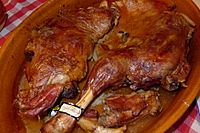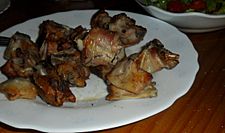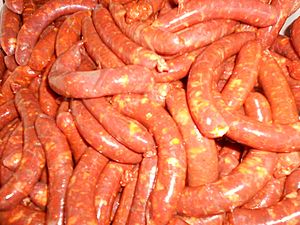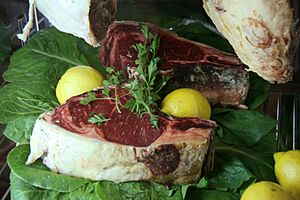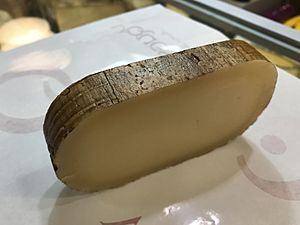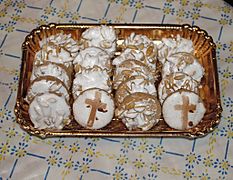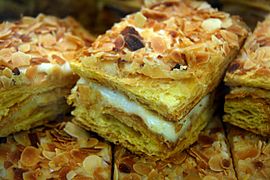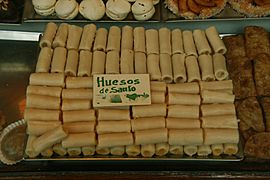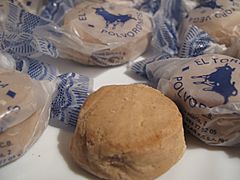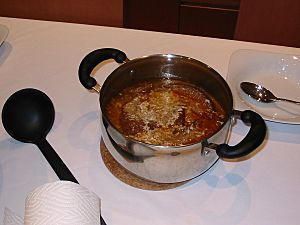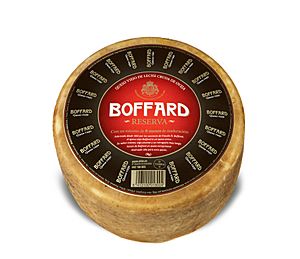Cuisine of Valladolid facts for kids
The gastronomy of the province of Valladolid is all about the delicious food, how it's made, and the eating traditions in the Province of Valladolid in Spain. This region is especially famous for its amazing barbecued and roasted dishes, like tender lamb and suckling pig. High-quality local wines are also a big part of every meal!
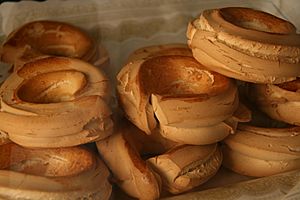

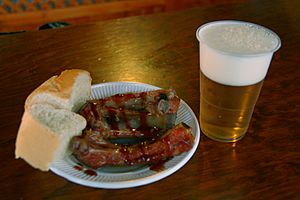
Contents
Delicious Ingredients
Grains and Bread
Valladolid grows many different cereals like wheat, maize, barley, and rye. These grains are used to make fantastic, high-quality breads. The region is also known for its excellent cheese, such as queso de Villalón, which is similar to queso de Burgos.
Vegetables and Legumes
You'll find many tasty vegetable dishes here. For example, there's sopa de chícharos (which is pea soup) made with fresh peas. Another popular dish is coliflor al ajoarriero (cauliflower with garlic). For legumes, people enjoy dishes like alubias con patuño de cerdo (beans with pork leg). And don't forget the famous sopa de ajo (garlic soup), a simple but flavorful dish. The region also produces special garlic, like ajo de Vallelado.
Meats and Sausages
Meats and sausages from Valladolid are famous for their unique and delicious taste. The province is well-known for its Spanish-style roasted meats.
Some popular meat dishes include:
- Lechazo asado (roast veal or lamb)
- Cochinillo asado (roast suckling pig)
- Cordero asado (roast lamb)
- Morcilla (blood sausage)
- Asados al Sarmiento (roasted meat cooked with wine), a special dish in Santibáñez de Valcorba.
- Chuletones de buey (large ox steaks) with garlic, popular in Peñafiel.
You'll also find unique sausages like chitas, made from suckling pig meat, and morcilla de Valladolid, a blood sausage spiced with a special kind of onion. Salchichas (sausages) from Zaratán are also very popular. Chorizo is often used in dishes like tortilla de chorizo (chorizo omelette).
For smaller game, people enjoy conejo a la cazadora (rabbit cooked "hunter style").
Fish
Like other regions in Castile, Valladolid enjoys trout dishes. A common example is truchas con jamón (trout with ham).
Sweet Treats and Desserts
The province of Valladolid has many delicious pastries and desserts. Some of these sweet specialties include:
- Bolla de chicharrones (pork rind cake)
- Rosquillas de palo (stick donuts)
- Mantecados de Portillo (a type of crumbly shortbread)
- Bizcochos de Santa Clara from Tordesillas (Santa Clara cakes)
- Hojuelas (thin, crispy fried pastries)
You can also find classic desserts like arroz con leche (rice pudding), which is popular everywhere.
Special Holiday Foods
Valladolid has many food traditions linked to special holidays throughout the year.
Holy Week
During Holy Week, which is the week before Easter, people eat special foods, especially desserts.
Local Celebrations
On September 8, during the celebration of the Virgen de San Lorenzo in Valladolid, sweets, pastries, and other desserts are served. A highlight is the tarta de San Lorenzo (pie of Saint Laurence).
Autumn Holidays
Around Halloween and All Saints' Day (October 31 and November 1), it's very common to eat treats like Hueso de santo (saint's bones) and buñuelos (which are similar to fritters).
Christmas and New Year
Christmas brings a huge variety of sweet dishes. These include turrón (nougat), the famous polvorones from Tordesillas, marzipan, and candied almonds.
For main meals during Christmas, families often enjoy roasted suckling pig, chicken, turkey, capon, lamb, and seafood like bream and prawns.
On December 31, for New Year's Eve, there's a fun tradition: eating Twelve Grapes at midnight, one for each chime of the clock.
In the early morning of January 1, it's common to have "chocolate with churros" (fried dough pastries), either at home or in a cafe. On January 6, for Three Kings' Day, families share the traditional roscón de reyes (king cake).
-
"Puff pastry of San Lorenzo". During the celebration of the Virgen de San Lorenzo, pastas, pastries and other desserts are usually served.
-
Hueso de santo (saint's bones) and buñuelos (similar to fritters) are very typical of Halloween and All Saints' Day.
-
Polvorones of Tordesillas are one of the many typical products of the Gastronomy of Christmas.
Amazing Wines
The wines from the province of Valladolid are known worldwide for their excellent taste and quality. Many famous wines come from the Vega Sicilia winery. The province has five different wines that have a special "denomination of origin" (DO) label, which means they come from a specific area and meet high quality standards.
- Rueda Denomination of Origin: These wines were once served in the royal court! They are mostly white wines made from verdejo grapes, and also some Sauvignon blanc. You can find white, sparkling, red, rosé, and liqueur wines under this label.
- Ribera del Duero: These wines are made from a grape called "ink on the country" (Tempranillo). You can enjoy young red wines, reserve wines (aged longer), and old vine wines.
- Toro Designation of Origin: These wines are mainly white, rosé, and red.
- Tierra de León Denomination of Origin: These wines include white, rosé, and red varieties.
- Cigales Denomination of Origin: This region is especially known for its delicious rosé wines.
Popular Foods from Valladolid
Here's a quick list of some of the most popular foods and drinks you can find in Valladolid:
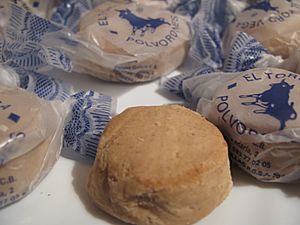

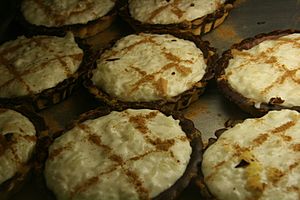
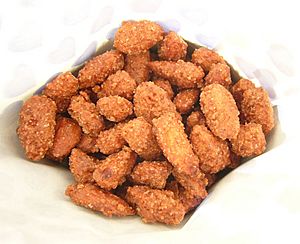
- Lechazo asado (roast lamb or veal)
- Cochinillo asado (Roast suckling pig)
- Cordero asado (roast lamb)
- Morcilla (Blood sausage)
- Tapa (Small appetizers or snacks)
- Bolla de chicharrones (pork rind cake)
- Gallo turresilano (Stewed cockerel)
- Mantecados de Portillo (Mantecados from Portillo)
- Gallina en pepitoria (chicken in egg and almond sauce)
- Queso pata de mulo de Villalón de Campos (Pata de mulo cheese from Villalón de Campos)
- Rosquillas de Palo (Bread donuts)
- Sopa de ajo (garlic soup)
- Feos de Tordesillas (Ugly cakes from Tordesillas)
- Amarguillos (small bitter cookies)
- Conejo (rabbit)
- Pichones estofados (stewed pigeon)
- Tortas de chicharrones (pork rind cake)
- Tortilla de chorizo (chorizo omelette)
- Morcilla de Valladolid (black pudding from Valladolid)
- Morcilla de Cigales (black pudding from Cigales)
- Piñones de Pedrajas de San Esteban (pine nuts from Pedrajas de San Esteban)
- Esparragos de Tudela de Duero (asparagus from Tudela de Duero)
- Sopa de chícharos (pea soup)
- Arroz con leche (rice pudding)
- Almendras Garrapiñadas de Villafrechos (Candied almonds from Villafrechos)
- Pan de la provincia de Valladolid (Bread from the province of Valladolid)
- Salchichas de Zaratán (sausages from Zaratán)
- Ajos de Portillo (garlic from Portillo)
- Ajo de Vallelado (garlic from Vallelado)
- Lechuga de Valladolid (lettuce from Valladolid)
- Vino de Cigales (Wine from Cigales)
- Vino de Ribera de Duero (Wine from Ribera de Duero)
- Vino de Rueda (Wine from Rueda)
- Vino de Tierra de León (Wine from Tierra de León)
- Vino of Toro (Wine from Toro)
Images for kids
See also
 In Spanish: Gastronomía de la provincia de Valladolid para niños
In Spanish: Gastronomía de la provincia de Valladolid para niños


